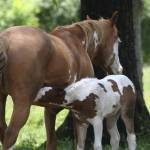Feeding Broodmares During Lactation

The mare must be kept in good body condition during lactation. After foaling, the mare’s nutrient requirements increase significantly during the next three months because milk is produced at a rate equal to 1-4% of body weight per day.
Mare’s milk is rich in energy, protein, calcium, phosphorus and vitamins. Some mares produce so much milk that the foal grows quickly, but the mare begins to lose condition, using her own muscle reserves to supply the protein needed for the milk.
Mares in early lactation may require up to 8 kg/day (17.6 lb) of grain, depending on the type and quality of the forage. The aim is to use the highest quality forage available and keep the grain proportion of the diet as low as possible to avoid digestive upsets.
If straight grains are used, they should be fortified with additional protein, minerals, and vitamins, such as with commercial balancer supplements, or the grain portion can be in the form of a complete mixed feed. Grain intake should be increased gradually during the last weeks of pregnancy so that the mare is consuming nearly the amount required for milk production by the time she foals. Increasing the grain portion at the time of foaling should be avoided because it may lead to colic or founder.
After nearly three months of lactation, milk production begins to decline and the grain intake can be reduced. It is often beneficial to reduce the mare’s grain ration just prior to weaning to help dry up the milk supply. Milk contains low levels of trace minerals and supplementation is not as important for lactating mares as for late pregnant mares. Research has shown that adding more trace minerals to the lactating mare’s diet does not change the composition of the milk. Calcium and phosphorus are the minerals of primary concern, and supplementation may be necessary.








